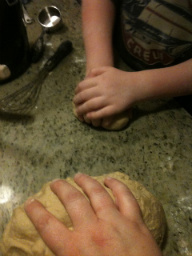
My attempt at Pain de Campagne
Since we are having a heat wave, I try to do everything in the mornings or late in the evenings. So, while I was making the English muffins, I had a starter going in the mixer beside me.
One of my favorite breads of all times is the Pain de Campagne which I can get at the farmer's market at Burke or at Whole Foods. It's such a big loaf, that you buy a section of it, not the whole thing and it's always expensive, which means, I rarely buy it. It's something like $6 for a section at Whole Foods.
Finding a recipe (several actually), I decide to give it a whirl. I know that breads with starters or bigas or pools lavains, or desems (so clueless what that all means still) have more flavor, last longer, get better air bubbles, and nicer crusts. Almost all artisan breads starts from one of these aforementioned 'blobs'. This particular starter is just an overnight (or minimum 4 hours) fermentation. Cool! I can try that!
So, beside me on the counter while making English muffins I had this yeast mixture growing (and man did it grow!). Come morning, I started the recipe - to the T. I first tried to convert the volume measurements to weight, but then realized, "Wait a minute, how do I know that MY weight measurements are the correct weights?" and they must not have been, because I was mixing a wet mess. I think I added about 1/2 cup more whole wheat and 1/2 cup more white to get it a still very wet, but more manageable dough.
The recipe then states to let it rise for 3-4 hours - until it doubles. Which is what I did (top photo is after this rise). It need not quite 3 hours. 
Then the tricky part - this is a wet dough - wetter than any I've ever worked with, how will I shape this blob of goo (kind of like the consistency of slime, just sticky). I get it out of the bowl and place it on a well floured counter and work it. Surprisingly, the dough with a little flour is quite manageable. I try to do the shaping of a boule technique.
Now it says to let it rise 2-3 hours until it triple is size. Ah, here's where I really worry. Will it rise? Will it stay round? And, like all previous attempts, it spreads out - not up or staying roundish, but spreads outwards. 
After two hours, I decide I should bake it. I try to slash one, but, again, as usual, I fail. I had a brand new razor blade, but it got stuck in the dough, didn't really slice it and made it deflate a bit - ARGH! Now it's even more flat! OK, fine, I'll just leave the other loaf as is and hope for the best.
In the oven they go and I watch and wait for a nice oven spring (more growth) and nope... again, as usual, not much happening. it bakes for 40 minutes on 425 degrees, I take it out and have a flattish bread. Let it cool and while it looks 'ok' and tastes good, it's still not quite right.



I go to get help here at The Fresh Loaf and the consensus is that I overproofed the loaves. Which, leaves me perplexed because how can I know? Which just shows me even more - I have so, so much to learn. Maybe I'll make a sweet quick bread tonight to give the yeast tries a rest. But, I'm also itching to start a try starter!


Comments
I think the art, in the big wet loaves, is being able to maintain the gas inside from the bulk fermentation, and at the same time creating very tight surface tension. The tightness of the top of the loaf will keep it from flattening as much. A nice tight skin will also make it easier to score.
As a novice myself, I can tell you that this is much easier said than done, and experience is your best friend. Here is a link to a video that may help.
http://pizzatherapy.com/shapingboule.htm
I have enjoyed eating my shortcomings though. :)
Keith